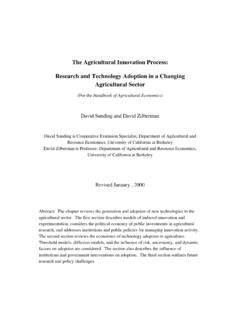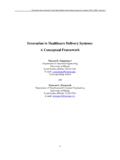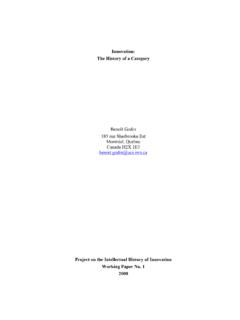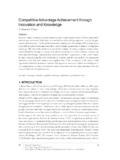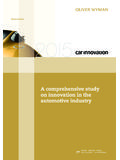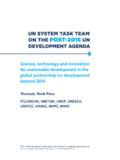Transcription of Innovation Models - Emotools
1 Innovation Models Paper 1 Professor Joe Tidd Science and Technology Policy Research Unit University of SussexDISCUSSION PAPER 1/ 1A Review of Innovation Models1A Review of Innovation ModelsProfessor Joe Tidd Professor of Technology Innovation and Management andDeputy Director, Science and Technology Policy Research Unit, University of Sussex Imperial College London 20061_InnovationModels 2/10/06 5:23 pm Page 1 DISCUSSION PAPER 1/ 2A Review of Innovation ModelsAbstractInnovation is central to the policy debate on how to maintain strong economicgrowth in an era that is increasingly being defined by the globalization ofcompetition, as well as major fiscal and demographic challenges. However,attempts to systematically draw on the concepts, theories and empiricalevidence accumulated over three decades of Innovation studies to inform thispolicy debate have been limited. In this paper we review Models of the Innovation process and the empiricalevidence for them.
2 We discuss the early linear, push-pull Models , which stillinfluence much practice and debate, and identify their many limitations. Wetrack the evolution of more realistic dynamic Models of Innovation , whichinvolve complex systems of disruptive and discontinuous events that involvenetworks of actors and sources. This latter perspective reveals some of thebottlenecks and unintentional dysfunctional implications that accompanypartial views of the Innovation process. In particular, we propose thatpreoccupation with the science base and novel inventions is insufficient,because commercial success is highly dependent on the later stages of theinnovation process, namely, development and , we consider appropriation, or sharing of the benefits created byinnovation, as well as the incentives and constraints that influence this processat the level of the firm and of society. We consider a range of factors thatinfluence this process and the implications for the rate, type and direction offuture Innovation .
3 In particular, we discuss the concepts of radical andincremental Innovation and their interpretation in the biopharmaceuticalssector. We suggest a number of ways to improve the dialogue betweenstakeholders to achieve a more balanced view of the whole Innovation process,which includes the mechanisms for the development, diffusion andappropriation of the benefits of innovations in the biopharmaceutical 2/10/06 5:23 pm Page 2 IntroductionTechnological and commercial Innovation is central to the policydebate on the future of Europe in an era of globalization andfiscal and demographic constraints. Little attempt has beenmade in the business and policy communities to systematicallydraw on the concepts, theories and empirical evidence thathave been developed over the past three decades of innovationstudies in order to improve the overall climate for Innovation . In this paper we review the different Models of theinnovation process.
4 We draw heavily upon recent reviews oftechnological Innovation (Tidd, 2006), organizationalinnovation (Isaksen and Tidd, 2006), and attempts tosynthesize technological , organizational and commercialaspects of the Innovation process (Tidd, Bessant and Pavitt,2005). We begin with an assessment of the limitations of themore conventional linear technology-push Models , and trackthe evolution to the more recent and realistic dynamicmodels of Innovation that feature a network of actors,sources and constraints. This latter perspective more readilyreveals some of the negative implications of a partial,disaggregated view of the Innovation process. In particular,it suggests that a focus on improving the science base andnovel technological Innovation is insufficient, because manyproblems occur during the later stages of the innovationprocess, in terms of development and we consider ways to apportion the costs and benefitsof Innovation , and the incentives and constraints that existat the level of the firm and the economy.
5 We consider thebalance between incremental and more radical forms ofinnovation, and the different stakeholders they might Models of theInnovation Process The importance of an understanding of Innovation as aprocess is that it shapes the way in which we try and manageit. This understanding has changed a great deal over Models (both explicit and, more importantly, the implicitmental Models whereby people managed the process) sawinnovation as a linear sequence of functional activities. Eithernew opportunities arising out of research gave rise toapplications and refinements which eventually found their wayto the marketplace ( technology push ), or else the marketsignaled needs for something new which then drew out newsolutions to the problem ( need pull , where necessitybecomes the mother of invention). The limitations of such anapproach are clear; in practice Innovation is a coupling andmatching process, where interaction is the critical the push will dominate, sometimes the pull , butsuccessful Innovation requires an interaction between the two.
6 One of the key problems in managing Innovation is to makesense of a complex, uncertain and highly risky set ofphenomena. Much recent work recognizes the limits of linearmodels, and tries to build more complexity and interactioninto the frameworks. Most Innovation is messy, involvingfalse starts, recycling between stages, dead ends, and jumpsout of sequence. In an important programme of case study-based research looking at widely different Innovation types,van de Ven and colleagues (2000) explored the limitations ofsimple Models of the process. They drew attention to thecomplex ways in which innovations actually evolve over time,and derived some important modifiers to the basic model : Shocks trigger innovations change happens whenpeople or organizations reach a threshold of opportunityor dissatisfaction Ideas proliferate after starting out in a single direction,the process proliferates into multiple, divergentprogressions Setbacks frequently arise, plans are overoptimistic,commitments escalate, mistakes accumulate and viciouscycles can develop Restructuring of the innovating unit often occurs throughexternal intervention, personnel changes or otherunexpected events Top management plays a key role in sponsoring butalso in criticizing and shaping Innovation Criteria for success shift over time, differ betweengroups, and make Innovation a political process Innovation involves learning.
7 But much of the outcome isdue to other events which occur as the innovationdevelops often making learning superstitious in nature Roy Rothwell was for many years a key researcher in the fieldof Innovation management, working at SPRU at the Universityof Sussex. In one of his later papers, he provided a usefulhistorical perspective on Innovation management, suggestingthat our appreciation of the nature of the Innovation processhas evolved from simple linear Models (characteristic of the1960s) to increasingly complex interactive Models (Table 1).His fifth-generation Innovation concept sees Innovation as amulti-actor process, which requires high levels of integrationat both intra- and inter-firm levels, and which is increasinglyfacilitated by IT-based networking. Table 1: Progress in conceptualizing Innovation :Rothwell s five generations of Innovation modelsGenerationKey features First and The linear Models need pull and secondtechnology push ThirdInteraction between different elements and feedback loops between them the coupling modelFourthThe parallel lines model , integration within the firm, upstream with key suppliers and downstream with demanding and active customers, emphasis on linkages and alliances FifthSystems integration and extensive networking, flexible and customized response, continuous Innovation Source: Adapted from Tidd, Bessant and Pavitt, PAPER 1/ 3 Enhancing Innovation in Biopharma R&D through Partnering Between Companies and Universities1_InnovationModels 2/10/06 5.
8 23 pm Page 3 Consequences of PartialUnderstanding of theInnovation Process Mental Models are important because they help us framethe issues which need managing, but therein also lies therisk. If our mental Models are limited, then our approach tomanaging Innovation is also likely to be limited. Examples ofsuch partial thinking include: Seeing Innovation as a linear technology push process(in which case all the attention goes into funding R&Dwith little input from users) or one in which only themarket is relied upon to pull through Innovation Seeing Innovation simply in terms of major breakthroughs and ignoring the significant potential ofincremental Innovation . In the case of electric lightbulbs, the original Edison design remained almostunchanged in concept, but incremental product andprocess improvement over the 16 years from 1880 to1896 led to a fall in price of the light bulb of around80%, thus ensuring its widespread use Seeing Innovation as a single isolated change ratherthan as part of a wider system Seeing Innovation as product or process only, withoutrecognizing the interrelationship between the two.
9 Table 2 provides an overview of the difficulties that arise ifwe take a partial view of Innovation (Tidd et al, 2005). Table 2: Problems of partial views of innovationIf Innovation is .. the result can beonly seen Strong R&D capabilityTechnology which fails to meet user needs and may not be accepted The province of Lack of involvement by others, specialistsand a lack of key knowledge and experience input from other perspectives in the R&DUnderstanding and Lack of technical progression, meeting customer leading to inability to gain needscompetitive edgeAdvances along the Producing products or services technology frontierwhich the market does not want or designing processes which do not meet the needs of the user and whose implementation is resistedThe province only of Weak small firms with too high a large firmsdependence on large customers. Disruptive Innovation as apparently insignificant small players seize new technical or market opportunitiesIf Innovation is.
10 The result can beonly seen Only about Neglect of the potential of breakthrough changesincremental Innovation : with an inability to secure and reinforce the gains from radical change because the incremental performance ratchet is not working wellOnly about strategically May miss out on lucky accidents targeted projectswhich open up new possibilitiesOnly associated with Failure to utilize the creativity of the key individualsremainder of employees, and to secure their inputs and perspectives to improve innovationOnly internally The not invented here effect, where generated good ideas from outside are resisted or rejectedOnly externally Innovation becomes simply a mattergenerated of filling a shopping list of needs from outside and there is little internal learning or development of technological competenceOnly concerning Excludes the possibility of various single firmsforms of inter-organizational networking to create new products, streamline shared processes.
